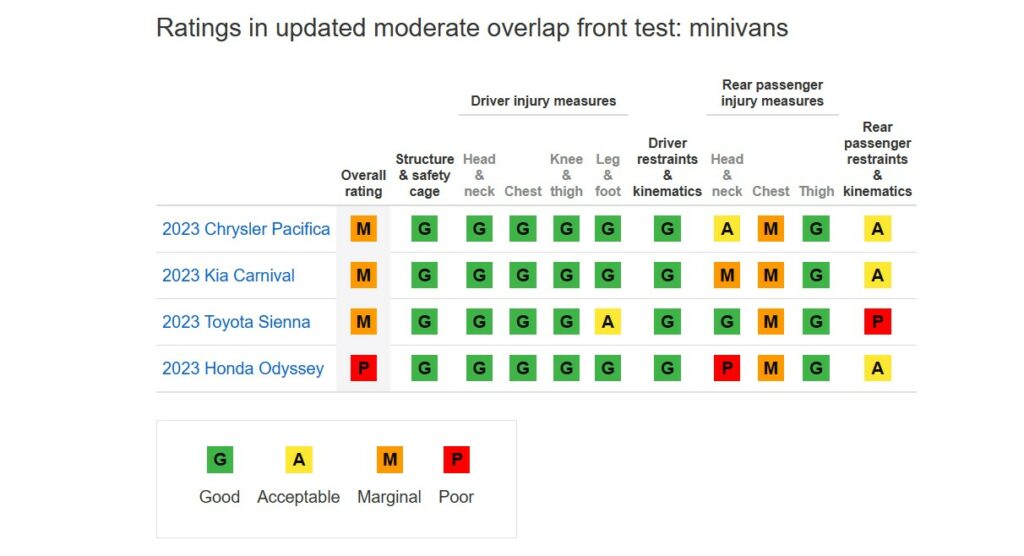
IIHS performs new crash test on four minivans, none score well
By onAnnouncements
The Insurance Institute for Highway Safety (IIHS) says all four minivans included in an updated moderate overlap front crash test failed to receive a favorable rating.
In a system ranking vehicles either good, acceptable, marginal or poor, the Chrysler Pacifica, Kia Carnival and Toyota Sienna were all rated marginal. The Honda Odyssey was rated poor.
The Sienna was the only one to include seat belt reminders for second-row occupants.
IIHS launched its updated moderate overlap front test last year after research indicated that in newer models, the risk of a deadly injury is higher for those in the second row than it is in the front.
“Back seat safety is important for all vehicles, but it’s especially vital for those, like minivans, that customers are choosing specifically to transport their families,” said David Harkey, IIHS president. “It’s disappointing that automakers haven’t acted faster to apply the best available technology to the second row in this vehicle class.”

In its original IIHS moderate overlap frontal test, a dummy representing an average-size man was positioned in the driver seat and a vehicle traveling 40 mph would strike a barrier on the driver’s side.
The exercise was meant to replicate the results from an actual frontal offset crash between two similarly sized vehicles traveling less than 40 mph. The original test was launched in 1995.
Until relatively recently, backseat passengers were less likely to die in a crash because of vehicle design. However, many automakers are now adding advanced seat belts and air bags in the front row, but not usually in the back, making the backseat a more dangerous place to be for those traveling in 2007 or newer models, IIHS said.
A recent IIHS study of real-world crashes showed that in many cases, back-seat passengers were injured more severely than front-seat occupants.
To encourage automakers to incorporate more safety factors in the rear seat, IIHS updated its test to incorporate a second dummy the size of a 12-year-old child in the second row behind the driver’s seat.
IIHS’ new metrics focus on the injuries most frequently seen in rear-seat occupants.
For a model to earn a good rating, measurements recorded by the second-row dummy’s sensor must not exceed limits that would indicate excessive risk of injury to the head, neck, chest, abdomen, or thigh, IIHS said.
Video footage and grease paint applied to the dummy’s head must also confirm that restraints prevented the head from striking the cabin or coming too close to the front seatback. Another requirement is that the vehicle design prevents the dummy from sliding beneath the seatbelt, which can cause abdominal injuries.
IIHS also used a pressure sensor during testing on the shoulder belt to gauge the risk of chest injuries. On top of that, it noted that the cabin must maintain enough space to keep the driver safe.
IIHS said while all four minivans provide good protection in the front seat, each is “plagued by multiple issues” in the second row.
“The restraint systems in all four vehicles leave the second-row occupant vulnerable to chest injuries, either because of excessive belt forces or poor belt positioning,” said Jessica Jermakian, IIHS vice president of vehicle research. “That’s concerning because those injuries can be life-threatening.”
Of the minivans tested, the Sienna was equipped with belt pretensioners and force limiters designed to reduce the belt force during a crash, IIHS said. However, it added that the rear dummy slipped under the belt during the test and that the belt slid off the shoulder toward the dummy’s neck.
Toyota declined comment when contacted by Repairer Driven News.
In the case of the Carnival and Pacifica, IIHS said the seat belt exerted too much force on the dummy’s chest and that the Pacifica’s side curtain airbag didn’t deploy.
Kia said in a statement provided to RDN that it will evaluate IIHS’ findings as part of “its commitment to continuous improvement in occupant protection.”
“Kia America places a priority on vehicle safety, and all Kia vehicles sold in the United States meet or exceed federal motor vehicle safety standards,” the statement said. “Occupant protection is complex and involves a diverse range of variables, and Kia is proud of its strong safety record and integrity of its products.”
Stellantis also issued a statement to RDN, saying all of its models either meet or exceed all applicable federal vehicle safety standards.
“No single test determines vehicle safety,” Stellantis said. “We engineer our vehicles for real-world performance. We routinely consider third-party ratings and factor them into our product development process, as appropriate. We have a long history in the minivan segment. The security and protection of our customers are critical concerns at Stellantis.”
IIHS said that in the poorly-rated Odyssey, the forces on the neck and head were higher and that the rear seat belt allowed the dummy’s head to get too close to the front seatback.
Honda said in a statement to RDN that it has been a leader in IIHS crash test ratings, with 10 Honda and Acura models recognized as top safety picks, including the 2023 Odyssey.
“IIHS’ updated moderate overlap testing with new rear passenger metrics challenges models fully engineered prior to the introduction of the new test mode, as seen by the results for each of the models included in the most recent minivan evaluations,” Honda said.
The OEM noted that the 2023 Honda Accord was the only midsize car tested to receive a good rating in a separate IIHS new rear-seat protection evaluation.
Of the seven vehicles IIHS included in the crash simulation, the 2023 Accord outperformed them all while earning its “rare” good rating, it said. Also tested were:
-
- The 2023 Subaru Outback, the only vehicle to receive an acceptable rating;
- The 2023 Nissan Altima, rated marginal;
- The 2023 Toyota Camry, rated marginal;
- The 2023 Hyundai Sonata, rated poor;
- The 2023 Kia K5, rated poor; and
- The 2023 Volkswagen Jetta, rated poor.
While all seven cars provided “good protection” in the front seat, IIHS said its measurements indicated a slightly higher risk of right leg or foot injuries in the Accord which provided “stellar protection” in the back seat.
Images
Featured image: 35007/iStock
